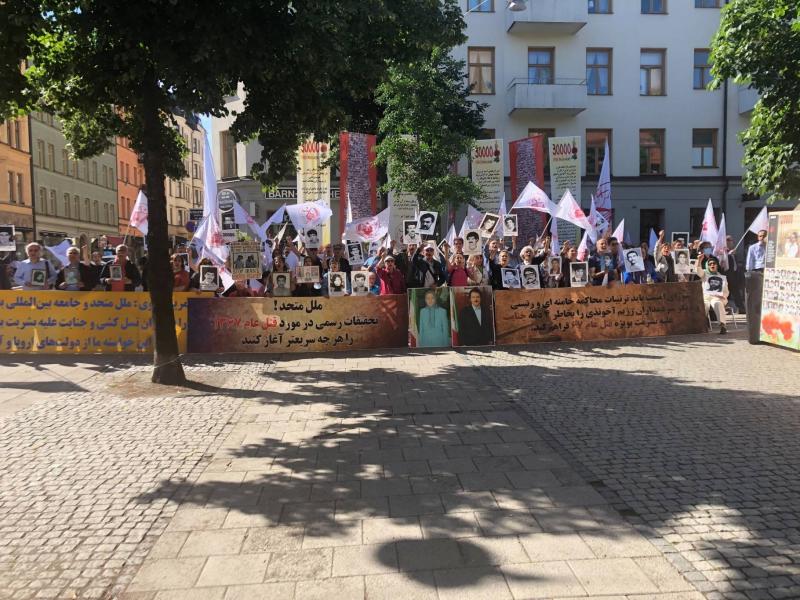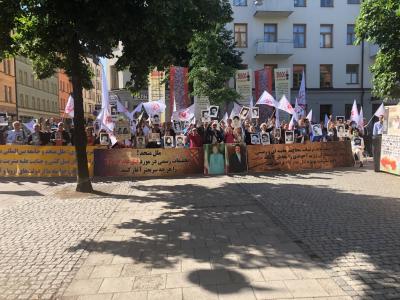On the third day of the trial on Thursday, the Stockholm court charged Hamid Nouri, a former Iranian prison official, with committing "war crimes" due to his involvement in the execution of 444 Iranian political prisoners in 1988, out of approximately 4,000 prisoners executed that summer. The trial has garnered significant international and media attention as it is the first prosecution of an Iranian official for "crimes against humanity" and "mass murder of prisoners of conscience," and he was arrested under universal jurisdiction.
The proceedings of the third court day began with prosecutor Kristina Karlsson presenting several documents that document the role of the "Death Committee," which included Iranian President Ebrahim Raisi, in issuing death sentences. The court also presented images of the "Death Committee" headquarters in Gohardasht Prison in Karaj, west of Tehran, during the mass executions of political prisoners, where the committee demanded that prisoners declare "repentance" and renounce their political affiliations, pledging loyalty to the regime, the revolution, and Khomeini to have their sentences mitigated.
The prosecutor explained that Hamid Nouri was among those who applied the most pressure and torture on prisoners to dissuade them from their stances, alongside Davood Lashkari, the prosecutor of Gohardasht Prison. She added: "They would take prisoners to the 'Death Corridor' to stand before the Death Committee for swift trials without the prisoners' right to defend themselves. The prisoners were blindfolded and handcuffed, waiting in line for field trials, and were often quickly sent to the execution hall thereafter."
The court reviewed a report from Amnesty International regarding the arbitrary and rapid trials of MEK prisoners, along with the random and mass executions, and the burial of those executed in unmarked mass graves in the Khavaran desert in Tehran. The court also displayed images of the "Death Corridor," where prisoners awaited trial in lines. Additionally, a drawing was presented showing the location of the "Death Committee" beside the site of the husayniya where executions were conducted by hanging. Prisoners were brought to these halls by Hamid Nouri and Davood Lashkari.
The prosecutor read excerpts from the testimony of former prisoner Hossein Farsi, a member of the MEK, who spoke about the executions that took place on July 30, 1988, stating that Hamid Nouri interrogated, beat, and mistreated him before presenting him to the "Death Committee." The second witness was Iraj Masdaki, who was interrogated by Nouri. Masdaki recounted that Nouri asked prisoners about leadership within the MEK, their whereabouts, and any information they might know about them.
The prosecutor also read the testimony of prisoner Mohammad Zand, who described how the prison's security chief, Mohammad Ghaisa, brought him before the "Death Committee" and instructed him to "answer the questions appropriately so that he does not meet his brother's fate," revealing at that moment that his brother, Reza Zand, had been executed with the previous batch of prisoners presented to the "Death Committee."
Additionally, the prosecutor read the names of those executed on the first day of the massacre, mentioning that on August 1, 1988, Hassan Kelzar and Asghar Mahdizadeh, two survivors of the executions, were brought before the "Death Committee" by Davood Lashkari and Hamid Nouri. Mahdizadeh testified that Nouri took him to see the corpses of MEK members and other prisoners on the execution platforms until he fainted.
The prosecutor presented testimonies from Reza Fallah, Mahmoud Rouyaei, and Akbar Samadi, with Samadi stating that Hamid Abbasi, who is currently Hamid Nouri, did not find his name among those who should be executed or presented before the Death Committee, so he placed him in solitary confinement.
The prosecutor mentioned that Hamid Nouri and Davood Lashkari deceived prisoners by telling them, "This is the committee of mercy you will appear before." She recounted stories and names of prisoners executed according to the memoir of prisoner Mahmoud Rouyaei. The book indicated that Hamid Nouri would take them to the gallows laughing and shouting, "Today is Ashura of the Mujahideen."
In the book "Aftabkaran," meaning "Sun Planters," Rouyaei documented the names of dozens of MEK members whom Hamid Nouri led to the gallows. When the prosecutor read the names and testimonies of two of them present in the courtroom, Nasrollah Marandi and Iraj Masdaki, Nouri looked at them as they looked back, appearing stern and showing no expressions on his face.
Throughout the session, Hamid Nouri monitored everyone in the room, taking notes on papers placed before him. The prosecutor continued reading the testimonies firmly, looking into his eyes, but he did not react and merely focused on the translators relaying the discussions from Swedish to Persian.
The Swedish prosecutor explained that thousands of prisoners listed for execution were transferred from Evin, Qezel Hessar, and Gohardasht prisons to a hall called the "Hall of Jihad" in Gohardasht Prison before the executions, where they would be interrogated before being presented to the "Death Committee," of which the majority were executed. She read the names of dozens executed during the post-massacre period, stating that the "Death Committee" returned to the prison to judge the remaining MEK prisoners, many of whom were executed.
According to the court, the bodies were transported to unmarked mass graves, and the victims' families have not been informed of the burial locations to this day, facing harassment and threats instead. The trial session was adjourned until next week, where the prosecutor will officially read the charges against Nouri before the defense team presents its testimony.




